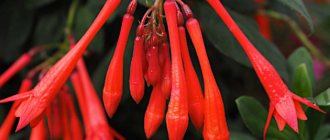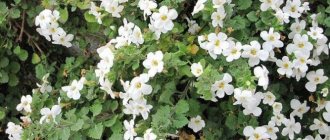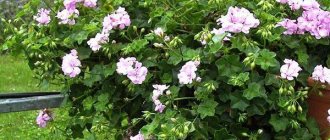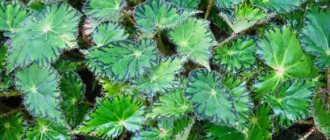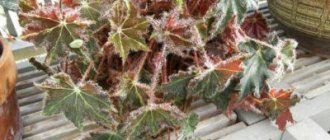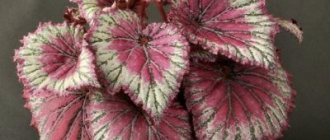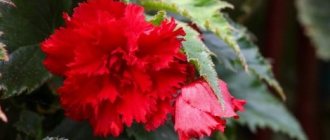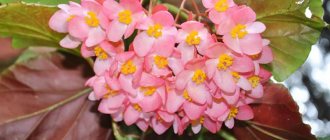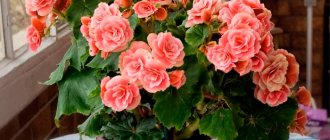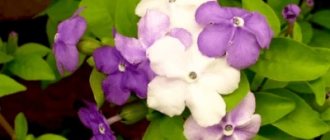The Begoniaceae family can turn the head of any lover of home floriculture. I was no exception and a long time ago I acquired a couple of chic flowerpots. Out of all the variety, I settled on two decorative deciduous varieties, but, of course, I couldn’t resist the blooming beauties with a thick “cap” of rose flowers.
During cultivation, my modest plants grew into luxurious begonias; I managed to breed many young specimens, which I shared with my friends. If you still doubt your abilities, I would like to tell you about my useful experience in growing these wonderful flowers.
How long does it take for begonia to grow from seeds, when to plant
Ampelous begonias reproduce in three ways: seeds, cuttings, and cutting tubers into pieces. The most popular method is propagation by grains. According to gardeners, mid-February is considered the optimal time for planting planting material. Seedlings need daily additional lighting. The recommended daylight hours are 13-14 hours.
ampelous begonia from seeds
Seeds germinate 2 weeks after planting. Sprouts may stop developing for some time. Don't worry, this is completely normal. During this period, water the plant especially carefully using a sprayer. Grown flowers are transplanted into separate containers.
How to germinate ampelous begonia seeds
The seeds of the decorative crop are germinated on thin cotton fabric. To do this prepare:
- a piece of gauze;
- flower seeds;
- water.
The gauze is moistened generously and transferred to a convenient container. Seeds of decorative crops are placed on top of the cotton fabric. The container is transferred to a bright and warm room. After 2 days, the seeds will begin to germinate.
Important! Germination of planting material allows you to accelerate the emergence of seedlings and achieve early flowering.
Ampelous begonia from seeds growing at home
Decorative crops can be grown at home. In order for the seedlings to be healthy and strong, it is important to follow the recommendations of experienced gardeners.
Soil for sowing
For planting, prepare a suitable soil mixture, which consists of 3 parts leaf soil, 3 parts chernozem soil, 1 part sand and 0.5 parts perlite. After preparation, the substrate is disinfected. To do this, use one of the methods suggested below:
- Freezing the ground.
- Treating the substrate with high temperature steam.
- Wet the soil abundantly with a weak solution of potassium permanganate.
- Watering the soil with boiling water.
After waiting until the temperature of the soil mixture drops to 20°C, flower growers begin planting work.
Advice! Instead of special soil, coconut/peat tablets are often used for planting ornamental crops.
Containers for sowing
Various containers are used for sowing grains. Below you can familiarize yourself with the features of growing begonia in each of them.
Napkins
A spacious container is covered with several layers of paper napkins, which need to be moistened generously. The seeds are poured onto paper, and the seedling boxes are covered with cling film and transferred to a well-lit room. After 3-4 days, the grains sprout. At this point, the film is removed from the pots.
Do not allow paper napkins to dry out. The finished sprouts are carefully removed and transplanted into the ground. Plants can be planted together with paper.
Peat tablets
The seeds are sown immediately and in peat tablets. For this, flower growers:
- Cover the surface of the bottom of the plastic container with a viscose napkin to achieve uniform distribution of moisture.
- Peat tablets provide abundant moisture. After they increase in volume, remove excess moisture. You can water them with a biogrowth stimulator.
- Make small holes in the tablets using a toothpick.
- The grains are evenly distributed on the tablets.
- The container is covered with a transparent lid and transferred to a warm, well-lit place. The cover is systematically removed for ventilation to prevent the formation of condensation. The room temperature is maintained within 19-20°C.
In winter, additional lighting is provided with a phytolamp. The recommended daylight hours are 13 hours. As soon as 3 leaves are formed on the plants, the begonia seedlings are transplanted into separate pots.
Pots
If you plant seeds directly into pots, they will not germinate well. This process can last 12-15 days. During this period, infections may manifest themselves, so high-quality seeds and disinfected soil are used for planting.
The pots with the planted grains are transferred to a room where the temperature reaches 25°C. The soil is systematically moistened. The recommended length of daylight is 13 hours, so plants need to be illuminated with a phytolamp.
To avoid mold, it is important to adhere to recommendations regarding germination conditions, which include:
- using sterile soil;
- regular loosening of the soil;
- proper watering;
- systematic ventilation of sprouts.
The room temperature should be within 20-22°C. As soon as 3 leaves are formed on the seedlings, the young plants are transplanted into separate, larger containers.
Male flowers
The fact that some types of double begonias produce inflorescences during the season is common for this plant, but not everyone is able to distinguish between female and male flowers.
The bottom line is that on begonia bushes, male and female flowers open almost equally, so not everyone can understand which one is where. In such a situation, you should know that the male flower is larger, unlike the female one, having a long stamen and terry fibers . The female flower is very simple and has a seed pod next to it.
When it comes to tuberous begonias, it is worth noting that it is best to leave only male inflorescences so that the plant does not waste its energy on maintaining seeds. There are often complaints that only male inflorescences bloom on a flower, or, on the contrary, only female ones, this means that the plant does not have enough moisture, or the climate differs significantly from its standard.
Seedling care
In order for seedlings to grow healthy and strong, you should properly care for them. Below you can familiarize yourself with the features of caring for a beautiful flowering plant.
Watering
The soil is moistened regularly. It is recommended to pour water into trays, since the use of overhead watering often leads to injury to tender shoots.
Advice! Do not pour water into the middle of the flowers. This will make it possible to avoid rotting of the root system.
Top dressing
To feed seedlings, use ready-made complex fertilizers intended for indoor plants. But it is better not to apply fertilizers that contain nitrogen into the soil. Nitrogen makes the stems watery, which increases the likelihood of rotting of the green mass.
Picking
60 days after sowing, the seedlings will begin to form 3-4 leaves. During this period, young plants need picking. A layer of drainage and soil mixture are poured into spacious pots and flowers are planted. The recommended height of picking pots is 10-15 cm.
Advice! To decorate hanging baskets, 3-5 plants are planted in flat wide pots at a time.
Lighting
When growing hanging begonia with seeds, it is important to create optimal conditions for the full growth and development of the crop. The room in which the flower pots are placed should have bright, diffused light. Do not allow direct sunlight to hit the foliage. Begonia is a tropical crop. That is why it is provided with high air humidity (60-70%).
Variety "Women's weapons"
The flower received this name because its glamorous bright red center of the leaf and the same red border attracts the eye no worse than any woman, and the sharp mesh leaves look like an evening dress. The begonia leaf has an asymmetrical shape, covered with small fibers. The stem of the flower is juicy, watery, and quite large in size. This stem is designed to retain moisture in the plant and support massive leaves.
Begonia has many medicinal properties. For example, it is very useful to have such a flower at home for those people who have severe chronic bronchitis, or those suffering from a smoking habit. Many people also use it to treat wounds, burns, and bites, as it has antiseptic properties.
Features of sowing ampelous begonia seeds
Decorative culture differs from other flowers in its harmony, attractiveness and tenderness. To grow healthy and strong bushes that will delight you with abundant flowering and gorgeous asymmetrical petals, you should adhere to the peculiarities of sowing plant seeds. Below you can find information on how to grow ampelous begonia from seeds.
Variety Chanson
Double and semi-double flowers of a perennial that does not overwinter in open ground are painted in dark red and vanilla-yellow tones. The bushes consist of 6-8 main shoots. The diameter of the regularly shaped flowers reaches 7-8 cm. The seeds are sown for seedlings in early January. Planting material is planted in spacious boxes filled with a drainage layer and a suitable soil mixture. Seeds are sown superficially, avoiding deepening. The seedling boxes are moved to a room with bright, diffused light.
Tuberous
The soil for planting tuber crops should be slightly acidic. The plant's grains are very small. To facilitate the planting process, you can mix them with a small amount of sand. Planting material is sown or pressed one at a time into a pre-moistened soil mixture.
Ampelous F1 Venus
Flower seeds of the Venus F1 variety are sown in a soil mixture that consists of 1 part sand, 4 parts leaf soil and 1 part turf. The surface of the bottom of the seedling boxes is covered with a layer of expanded clay and crushed shards. The grains should not be buried in the ground. They are placed on the surface of the soil and lightly sprinkled with sand.
Carmen
Planting material of this variety is sown in early February. The soil should be peaty and loose. It can be purchased in a store or prepared at home by combining 1 part fertile soil, 1 part leaf soil, 1 part humus and 0.5 parts sand. The grains are carefully distributed over the surface of the soil and lightly sprinkled with sand.
Hellas
Flower growers recommend planting the variety for seedlings in the last week of February. It is convenient to do sowings in spacious boxes. The soil is moistened abundantly 4-5 hours before planting. Small grains are carefully distributed over the surface of the soil mixture and sprinkled with sand.
Illumination White F1
Ornamental crops are planted in mid-February. Seeds of the Illumination White F1 variety are sown in seedling boxes, the depth of which does not exceed 20 cm. The soil is moistened as the top layer dries.
Variety Margarita
This variety of beautiful flowering plant is planted in fertile soil. Before sowing the grains, the soil is moistened abundantly. Sowing is carried out in mid-February.
Diseases
Let's look at some of the causes of begonia disease:
- Pests (aphids, whiteflies, scale insects, red spider mites, etc.) To avoid such pests, the plant should be treated with various types of complex chemicals, such as: topaz, copper sulfate, speed, HOM, etc.
- Fungal infection.
- Incorrect care. Very often, the leaves and petioles of begonia are subject to fungal diseases, the most common being powdery mildew. In most cases, this is due to an excess of moisture in the soil or drops of water falling on the leaves of the plant.
Read more about begonia diseases here.
If you avoid these troubles and take care of them competently and attentively, the plant will soon thank us with its splendor and bright flowering.
Forum, reviews
Below you can read reviews from flower growers who grow hanging begonias from seeds at home.
Margarita, 39 years old, Moscow: “The main decoration of my garden has always been begonia. Numerous flowers on cascading stems look simply amazing. A couple of years ago I started growing ornamental crops at home. I purchase planting material only from a trusted manufacturer. I immediately plant the grains in peat tablets. The seedlings grow strong, healthy and delight with abundant flowering.”
Angelina, 47 years old, Saratov: “Every year I plant begonia at my summer cottage. I grow decorative seedlings myself. I sow the seeds in pots at the end of February, and transplant them into open ground no earlier than May 1st. I place containers with young plants in a room with bright, diffused light. The room temperature reaches 22°C. The flowering of the decorative crop continues for several months.”

